
Admin
In sodales tellus ac erat malesuada ac viverra lectus tempor.
Young engineers choose Additive Manufacturing (AM) to tap the full potential of the part.

The greater the force in play, the greater the resulting counter-force – a relatively basic rule of physics. Such rules are particularly relevant in motorsports, where the stresses placed on the utilized materials are extreme. Taking the circuit at high speeds exposes both driver and car to the effects of such forces.
The young constructors of the Rennteam Uni Stuttgart are constantly striving to optimise the construction process and the use of materials. More and more, the sport demands that not only should the driver pilot the car ever quicker around the track but, within the principles of the Formula Student Germany series, he should do it safely. In the construction of the successful 2012 model the student engineers employed for the first time an additive manufacturing process in the building of the knuckles - and the car went on to win the title.
Challenge
The knuckle – also called the axle-pivot – connects the wheel axle with the wishbones and the track rod via a bearing. The braking system is then likewise fixed to it. The part conducts all the forces and momentum absorbed from the wheels to the wishbones and the tie rod, and on to the vehicle chassis itself. On the one hand, every constructor of an axle-pivot has the task of developing a part with the highest possible stability – otherwise the safety of the vehicle as a whole would be undermined. Besides a fracture, part deformation can also have serious consequences, as the kinematic design and, as a result, the drivability, would be negatively impacted. On the other hand, the wheel mounts cannot, for a number of reasons, weigh too much. Every additional gramme increases lap times, and the wheel mounts belong to the so-called unsprung mass of a vehicle. The less there is of this mass, the better the suspension and shock absorption will function. A low wheel-mount weight allows the car to sit better on the track – important for fast laps and safe racing. As a consequence, constructors are faced with the tricky task of finding the perfect balance between rigidity and weight. Previous production technologies offered the Stuttgart race team too little room to maneuver in the search for this perfect balance.
“The wheel mount we‘d been using over the last few years had already achieved a good balance between weight and rigidity, but we were sure we could improve on it,” explains Yannick Löw from the Rennteam Uni Stuttgart.
“We produced the part using the classic precision casting process. This, of course, led to limitations in freedom of form, which meant that the part‘s potential could never be fully realized. Even back then we‘d decided that for the 2012 season we‘d investigate new, innovative ways of manufacturing the steering stub axle.” It didn‘t take long for the team to decide upon the path to take: The EOS AM technology.
Solution
As early as the conceptual design phase, the engineers utilised the CAD software from EOS Partner Within Technologies Ltd. Within is a young company, whose programmers wrote their software specifically for the AM process. The program makes possible the optimisation of latticed micro-structures of variable densities following examples found in nature. Thanks to this tool the constructors were able to match the part perfectly to the structural requirements. In this way, they were able to give the knuckle precisely the required physical properties – light-weight plus rigidity.
“By the simplified, so called, 3D-Print process, our machine honed powdered metal granules with the help of a laser, layer by layer, into the required part,” explains Nikolai Zaepernick, Business Development Manager Automotive at EOS.
“The victorious team from Stuttgart decided on our partner Within’s software for the construction of the CAD model, as it was the most suited for the part and its purpose. The information for the manufacture of the part was provided for the Direct Metal Laser Sintering (DMLS) system from our universally deployable software, which had, so to say, translated the information from the existing 3D-CAD-model. The result was amazing and showed just how much the young engineers already understand about their subject.”
Once the team had designed the steering stub axle, the production of the first component parts followed immediately. The fact that the development and production time could be significantly shortened when compared to previously utilised processes was important for the team. There were a number of reasons for the time savings. One is that with additive manufacturing the need to build negatives or mould forms falls by the wayside. In addition the entire process, from design through fabrication is more precise, meaning that often no reworking or refining is required. In this case the constructors from Stuttgart reached a high production quality in a very short time with minimal honing for fit, so that the part was almost immediately race-ready.
Results
The advantages can be summed up in concrete figures: The weight of the part was reduced by 660 grammes, saving the Rennteam Uni Stuttgart 35 per cent. At the same time the engineers succeeded in increasing the rigidity by 20 per cent – big numbers for motorsports, and numbers that translate into faster lap times and reduced fuel consumption. The best testimony was delivered by the team with the result in the final race of the series – a victory at the Hockenheimring that crowned the Stuttgart race team as Formula Student Germany Champions 2012.
All those involved have shown with this victory that the engineering profession can be a lot of fun – and ultimately, that there are a multitude of interesting and exciting ways of responding to the shortage of technical specialists. And the allure of new technologies, such as additive manufacturing, can play a role in this, inspiring down the line more and more young people to take a serious look at a career in engineering.
“We are thrilled to have been able to bring the Formula Student Germany 2012 title to Stuttgart.
The freedom in the construction process offered by the DMLS technology from EOS has played an important role in our success.” Yannick Löw, Rennteam Uni Stuttgart.

This feature is brought to you by EOS Singapore Pte Ltd.
Packaging is used across a wide range of consumer sectors, as well as some business and industrial categories. Such is its ubiquitousness in everyday life that the packaging usage rates are often closely aligned with the general ebb and flow of the broader economy.

The Changing Significance of Packaging
Packaging is an important – if sometimes overlooked – aspect of the product experience. At its most basic level, a piece of packaging serves but to carry and protect the contents within it. Or in the case of food and drink packaging, it must also prevent spoilage and retain nutritional value. But going beyond basic functionality, one would see that today’s packaging is expected to be so much more – attractive to consumers, friendly to the environment, all while staying cost effective to produce.
Global Outlook
According to a research report compiled by Smithers Pira, the global packaging market stood at US$799 billion in 2012. Packaging sales are projected to increase by 3 per cent in real terms for 2013 to US$824 billion. The report is also forecasting annual growth of 4 per cent per year to 2018 in the world packaging market, with sales to reach over 1 trillion US dollars by 2018.
Globally, much of the demand is expected to come from the emerging markets of Brazil, Russia, India and China, increasing in line with the development of their economies. Strong growth is expected with increased consumption and demand for consumer goods driving the need for more sophisticated packaging.
One of the key issues faced by packaging companies (known in the industry as “convertors”) is managing the costs of their raw materials. This is especially critical given that raw materials make up more than half of the manufacturing cost of packaging and packaging producers may not have the clout to pass on any price increases to their customer base.
Production Machinery
The packaging manufacturing business is a capital-intensive one, requiring sophisticated printing and converting machines to deliver the necessary quality and production efficiency. According to a study by the Freedonia Group, worldwide demand for packaging machinery is expected to grow at a pace of 4.6 per cent per annum through to US$41.8 billion in 2017.
The US is currently the largest market in the world for packaging machinery, with demand expected to hit US$6.4 billion by 2017. However, China is expanding at a rapid pace too and is expected to overtake the US marginally by 2017, accounting for US$6.9 billion in demand then.
As a region, the Asia Pacific will also see packaging machinery shipments grow rapidly through to 2017. Both smaller packaging firms from the region and larger foreign multinationals will look to ramp up their manufacturing capabilities and capacity to meet the growing demand for packaging from Asia’s markets.
Additionally, changing demographic and consumer lifestyle trends, as well as increased competition between fast-moving consumer goods (FMCG) companies, have created demand for innovations in packaging, such as resealable pouches for snacks. The production of new specifications require investment in new machinery, which is expected to add to their growing demand.
Sustainability of Packaging
The key development in Singapore’s packaging industry in recent years has been the increasing number of packaging producers committing to reduce packaging waste. This growing movement is largely the result of continuous efforts by the National Environment Agency (NEA) to promote the cause.
In 2007, the NEA launched the Singapore Packaging Agreement (SPA), which was signed by 32 signatories. The Agreement outlined a platform and structure for businesses to collaborate with the government in reducing packaging waste. When the first SPA expired in June 2012, a second SPA was effected. This time, a total of 159 signatories came onboard.
To date, the participating companies have reduced some 20,000 tonnes of packaging waste in total. This has been achieved through measures such as innovative packaging redesign. Apart from reducing waste at source, these signatories also saved a total of S$44 million in production and material costs.
Industry to Grow in Tandem with the Economy
In conclusion, the packaging sector looks set for a sustained period of growth in the years ahead, riding on the global economy recovery that has been getting underway for some time now. And while the industry has largely matured, its correlation with the broader economy suggests that it will continue to prosper as long as consumer demand remains resilient.
Addictive manufacturing increases productivity for organisations and helps them stay competitive in their respective industries.

There are so many potential benefits that 3D printing can provide. Here are some of them, summarised in 5Cs:
1. Compression of Time
From conceptualisation to realisation, 3D printing is able to shorten the time it takes to bring your product to market – be it in the replacement of parts or coming up of a new product to introduce into the market. Traditionally, new idea prototypes would be sent to a specialised company to be produced which can take up to weeks to ship back. With 3D printing technology, this can be done within hours and in-house.
2. Cost of Error
Holding a physical 3D object in one’s hand enables the individual to discover possible product issues before it is sent into full production. Errors can then be resolved easily in a 3D software and subsequently printed out on a 3D printer. All these reduce potential costs of errors involved in full-scale production.
3. Confidentiality
With the highly competitive landscape evident in every industry, new product design may potentially be leaked out when companies start to outsource their design process. Having an in-house 3D printer eliminates this possibility, providing peace of mind that their product secrecy is kept at the maximum.
4. Creativity
When your own system is always available, the sky is the limit. With 3D printing technology, companies are able to bring ideas to reality with just a click of the button.
5. Communication
Having a tangible, physical product model can ensure better visualisation and discussion during meetings as compared to traditional 2D drawings. Better communication through the physical 3D object leads to increased productivity, which also enables conveying of ideas to potential clients in a more effective manner.
To find out more about 3D Printers, visit http://www.creatz3d.com.sg.

This feature is brought to you by Creatz3D Pte Ltd
About the Awards
The FIABCI Prix d’Excellence recognizes the project that best embodies excellence in all the real estate disciplines involved in its creation. It illustrates concretely the FIABCI ideal of ‘providing society with the optimal solution to its property needs’ and even mature projects are eligible.
Awarded by an international panel comprising top real estate professionals and experts, the FIABCI Prix d’Excellence rewards overall merit and not just aesthetics, functionality or size.
It therefore represents an outstanding achievement and bestows upon the winner the right to use the coveted exclusive award logo. Winners also gain access to unique international platforms for their projects and companies throughout the extensive FIABCI network of more than 60 members’ countries and over 120 professional organizations worldwide.
The Prix d’Excellence is much more than just a beauty contest. It represents projects that are a cut above the rest!
Presented here are the Singapore winners of the 2014 FIABCI Prix d’Excellence.
World Gold Winner - Hotel Category

PARKROYAL on Pickering, Singapore
PARKROYAL on Pickering is located in the Central Area of Singapore, at Upper Pickering Street. It is at an important confluence point between the Singapore River, Clarke Quay, Chinatown and the Central Business District (CBD). The development is located within walking distance from Clarke Quay and Chinatown MRT stations as well as the Raffles Place MRT station in the CBD.
Its architectural design is one that responds appropriately to its unique site context of being adjacent to a green lung within the city centre. It is a lush retreat right in the heart of the city that you cannot get from any other high-rise business hotel.
Over 15,000m2 of elevated sky gardens, water features, planted terraces and green walls were designed, which make up 215% of its site area. The design adapted the idea of our sprawling garden city onto the high-rise building typology with the same sense of relief and delight as one would get from a park on the ground. Extensive landscaping is introduced, which allows alternative approaches to be taken without compromising the comfort and amenity of end-users. Guestroom corridors, lobbies and washrooms were designed as attractive garden spaces, naturally ventilated, shaded by tropical trees and flanked by water features.
In addition, the hotel is managed by the Pan Pacific Hotels Group, a subsidiary of UOL Group Limited, under its acclaimed PARKROYAL brand. With experience in managing over 30 hotels, resorts and service suites with over 10,000 rooms worldwide, a high level of service standards is rendered, enhancing the overall experience for the guest.
These factors combined with its proximity to the Central Business District and popular tourist enclaves like Clark Quay and Chinatown, were instrumental to the development's success.
Project Address:3 Upper Pickering Street
Singapore 058289
Owner:
UOL Group Limited
101 Thomson Road #33-00
United Square
Singapore 307591
Architect:
WOHA
World Gold Winner - Residential (High Rise) Category
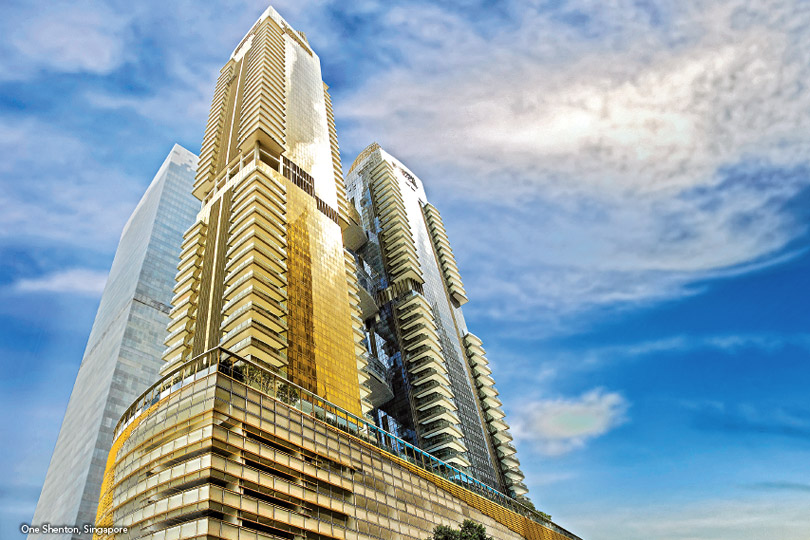
One Shenton, Singapore
Singapore's leading developer, City Developments Limited (CDL) is honoured to present One Shenton – an architectural gem that gleams as the jewel in the crown of Singapore's new downtown.
Multiple award-winning world-renowned architect Carlos Ott was commissioned to create a stunning design for One Shenton which comprises 341 luxury apartments and penthouses. Towering majestically at 50 storeys and 43 storeys high, with its distinctive gold and silver two towers topped with iconic crowns, One Shenton is visually bonded with three sky bridges – the first of its kind in Singapore. The main intent was to create a thoroughly modern and unique sculptural structure with a strong silhouette and a striking façade in silver and gold that reflects the dynamic pulse of city living.
The sky bridges accommodate duplex Sky Suites, which come with jet pools, located on 16th to 17th, 26th to 27th and 33rd to 34th floors. These bridges include the Wellness Levels on the 24th and 25th floors which provide a Sky Gym, Spa Garden, Outdoor Fitness Area and a host of facilities.
One Shenton, with its city and waterfront views, has an enviable location in the heart of the Central Business District at the edge of Marina Bay, Singapore's premier waterfront destination, close to the Marina Bay Sands Integrated Resort. Also located in this area are the new Business Financial Centre, Gardens by the Bay and an array of leisure, commercial and entertainment facilities. Raffles MRT Station and the upcoming Landmark MRT Station is only a short walk away. With all the attractions nearby, One Shenton is the epitome of a stylish and dynamic city lifestyle.
This high profile project was launched for pre-sales (before development) in 2007 and received very good response from buyers. It was completed in 2011.
Project Address:1 Shenton Way
Singapore 068803
Developer:
City Developments Limited
36 Robinson Road #02-01 City House
Singapore 068877
Architect:
Carlos Ott, Architects 61, Singapore
World Silver Winner - Heritage (Restoration/Conservation) Category
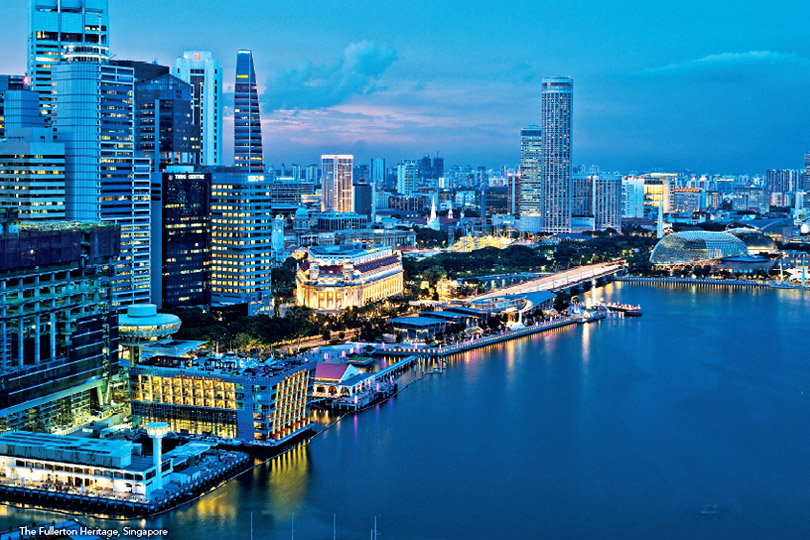
The Fullerton Heritage, Singapore
Fronting the historical waterfront, Fullerton Heritage is a landmark site that embraces Singapore's heritage and urban sensibility. It comprises four conserved buildings: The Fullerton Hotel Singapore, Fullerton Waterboat House, Clifford Pier and Customs House, and newly-built Fullerton Bay Hotel, Fullerton Pavilion and One Fullerton. It demonstrates successful integration of new uses within restored buildings, where new and old co-exist, revitalising Marina Bay precinct. One can now enjoy the waterfront freely, enjoy views of new Singapore and reminisce our historical past. Indeed, The Fullerton Heritage has fulfilled the balance of preserving our national monuments, achieving commercial viability and contributing to nation-building.
Project Address:
1 Fullerton Road
Singapore 049213
Owner:
Precious Quay Pte Ltd
14 Scotts Road, #06-00
Far East Plaza
Singapore 228213
Architect:
DP Architects Pte Ltd, Singapore
World Silver Winner - Hotel Category
W Singapore – Sentosa Cove, Singapore
Inspired by a dynamic cosmopolitan lifestyle, the 7-storey W Singapore – Sentosa Cove hotel features 240 guestrooms with stunning marina and golf-course views. It is part of a winning 3-in-1 concept that offers residents, tourists and locals the opportunity to experience a tropical marina-oriented lifestyle, with Singapore's first W hotel, specialty retail shops and quaint restaurants (Quayside Isle) as well as luxury residences (The Residences at W Singapore – Sentosa Cove).
The hotel facilities include a signature restaurant (SKIRT), an all-day dining restaurant (the kitchen table), an indoor bar (WOOBAR), an outdoor pool bar (WET® Bar) and a 500-seat ballroom, amongst others.
Project Address:21 Ocean Way
Singapore 098374
Owner:
City Development Singapore
9 Raffles Place
#36-00 Republic Plaza
Singapore
Concept Designer:
Wimberly Allicon Tong & Goo, Singapore
Architect:
AXIS Architects Planners Pte Ltd., Singapore
This feature is courtesy of the FIABCI World Prix d’Excellence Awards Secretariat
Despite the sluggish global economy in 2014 and the slow pace of recovery, Singapore’s economy is expected to grow between 2.5 to 3.5 per cent in 2014. Growth of 2 to 4 per cent is projected for 2015, according to the Ministry of Trade and Industry (MTI), as the global economy is expected to strengthen modestly. However, the slow pace of global economic recovery has led the local business outlook to score the lowest score in two years on the Business Optimism Index (BOI) with a score of +1.11. Regardless of the BOI score, Asia, excluding Japan is expected to grow steadily in 2015. The Monetary Authority of Singapore (MAS) announced in a statement on 28 January that it will adjust its monetary policy and let the Singapore dollar appreciate at a slower rate. This led to an immediate weakening of the Singapore dollar against currencies such as the US dollar, which in turn is expected to ease some pressure on Singapore exporters.

Singapore’s Construction Industry
The Singapore economy grew in the first three quarters of 2014 by 4.8 per cent, 2.3 per cent and 2.8 per cent respectively on a year-on-year basis. On a quarter-on-quarter seasonally-adjusted annualised basis, the economy grew by 3.1 per cent in the third quarter after a 1.9 per cent growth in the first quarter and a -0.3 contraction in the second quarter. The Ministry of Trade and Industry (MTI) expects Singapore growth in 2015 to remain modest at 2 to 4 per cent.
Some domestically-oriented sectors such as business services are expected to remain resilient for the rest of 2015, but labour-intensive sectors such as construction, retail and food services continue to face problems with tightness in labour market conditions. These labour constraints could slow their growth.
Advance estimates predict that the construction sector grew by 3.0 per cent in 2014, compared to 6.1 per cent in 2013. On a quarter-on-quarter basis, the sector grew by 1.8 per cent in the first quarter of 2014 before contracting by 6.1 per cent in the second. Slight growth of 0.1 per cent occurred in the third quarter, before rebounding by 8.0 per cent in the final quarter. Compared to the corresponding periods of 2013, the first three quarters of 2014 showed even greater increases of 10.5 per cent, 7.7 per cent and 5.8 per cent respectively. However, as tight labour conditions continue into 2015, the construction industry’s growth is expected to be modest.Real Estate Prices and Rentals
Although prices of private residential properties rose marginally in the first three quarters of 2013, they began falling in the last quarter and continued falling through all four quarters of 2014 as the effects of the cooling measures implemented in 2013 kicked in. Statistics from the Urban Redevelopment Authority (URA) indicate that for the whole of 2014, prices have fallen by 4.0 per cent compared to an increase of 1.1 per cent for 2013. This is the first year of overall decline since 2008. Prices of private residential properties decreased by 1.1 per cent in the fourth quarter of 2014, the fifth straight quarter of decline. Prices declined by 0.7 per cent and 1.0 per cent in the previous two quarters of 2014 respectively. As a result, there have been calls to reduce the cooling measures and in February 2014, the Monetary Authority of Singapore announced the broadening of exemption from the Total Debt Service Ratio (TDSR) threshold for refinancing of owner-occupied residential properties purchased before the implementation of TSDR rules.
The luxury property market has been the hardest hit by the drop in private residential property prices, with reports of more luxury properties being sold at loss-making prices as a growing number of wealthy owners sell off their properties. According to data from Maybank Kim Eng, most of these properties are located in District 9 and Sentosa Island, areas which have traditionally attracted more foreign interest than other parts of Singapore. However, 90 per cent of properties were sold upon first auction listing in Q4 of 2014, compared to 80 per cent and 54 per cent in the preceding two quarters according to data from JLL. This can largely be attributed to a compromise of sellers’ and buyers’ price expectations, and proves that a weaker market is not necessarily an impediment to selling.
On the rentals front, private rental prices for non-landed private residential property dropped for 11 consecutive months since February 2014. According to the Singapore Real Estate Exchange (SRX) Property Price Index for Non-landed Private Residential Rentals, rents posted a drop of 0.8 per cent in December compared to November. Rents have already declined 6.4 per cent since the start of the year, and shoebox rentals are expected to drop anywhere from 5 to 10 per cent, especially for units that are further from the city centre or MRT stations. A record 6,200 shoebox units are slated for completion over the next two years, contributing to the fall in rental prices.Prices of office space were less volatile than that of private residential properties. After a slight increase of 0.5 per cent increase in the first and second quarters, prices further increased by 1.6 per cent in the third quarter and 2.4 per cent in the last quarter. Rentals rose 2.4 per cent, 2.8 per cent, 2.6 per cent and 1.7 per cent in each quarter of 2014 respectively.
As at the end of the fourth quarter of 2014, there was a total supply of about 908, 000 square metres GFA of office space in the pipeline.
Prices for shop space remained unchanged during the first quarter of 2014, before declining slightly by 0.3 per cent and a further 0.2 per cent in the second and third quarters. Prices increased by 1.5 per cent in the final quarter. Rentals declined by 0.3 per cent in the first quarter before increasing by 0.6 per cent, 0.1 per cent and 0.5 per cent in the remaining quarters.
As at the end of 2014, there was a total supply of 785,000 square metres GFA of shop space from projects in the pipeline.
According to JTC’s industrial property market statistics, occupancy rates for industrial property reached their lowest levels since late 2007 in the second quarter of 2014. This was due to the increase in supply of industrial land by the Government in recent years. However, the price of all industrial space and multiple-factory space grew by 0.7 per cent and 2.5 per cent on a quarter-on-quarter basis in the same quarter. Prices declined in the third quarter of 2014 by 0.9 per cent and 1.8 per cent before falling further by 0.1 per cent and 0.2 per cent respectively in the final quarter.
Developments in Singapore’s Urban Landscape
Exciting times are afoot for Singapore’s built environment. The Government is pushing to develop Singapore as the world’s first Smart Nation, where transformational infocomm and media (ICM) technologies such as the Internet of Things (IoT), big data and analytics are utilised to make Singapore a better place to live, work and play. For more information on Singapore’s drive to transform itself into a Smart Nation, click here.
The introduction and adoption of higher productivity construction technologies such as the Prefabricated Pre-finished Volumetric Construction (PPVC) method and the use of new materials such as Cross Laminated Timber (CLT) are changing the construction game in Singapore, which has traditionally been extremely labour-intensive. According to Minister for National Development Khaw Boon Wan, these technologies can enable up to 50 and 35 per cent savings in manpower and time respectively. The government is implementing a requirement for these technologies to be used in the development of selected government land sales sites. Funding will also be provided by the BCA to support the adoption of these technologies. To read more about productivity improving technologies, click here.
Of course, Singapore’s push to continue greening the cityscape has not taken a backseat to technology adoption. As testament to green efforts, the Republic has been ranked among the world’s top 10 greenest cities in the Global Green Economy Index (GGEI) conducted by US-based environmental consultancy Dual Citizen. Furthermore, more than 61 hectares of building exteriors were planted with greenery by 2014, surpassing the initial goal of 50 hectares by 2030. With the new goal of 200 hectares of skyrise greenery by 2030, schemes and initiatives such as the National Parks Board’s Skyrise Greenery Incentive Scheme and the Urban Redevelopment Authority’s enhanced Landscaping for Urban Spaces and High-Rises (LUSH) programme will spearhead the continued green efforts.
Skyrise greenery is only one of the aspects where Singapore has reached its target ahead of time; the first Sustainable Singapore Blueprint was released in 2009, and the 2015 iteration will see other 2030 goals extended. The Sustainable Singapore Blueprint 2015 will focus on three areas: 1) A Liveable & Endearing Home; 2) A Vibrant & Sustainable City; and 3) An Active & Gracious Community. More parks will be developed close to homes, and more bicycle paths will be built to encourage the adoption of cycling as a mode of transport. Recycling, encouraging the adoption of greener modes of transport and the increased use of renewable energy sources such as solar power are also part of the Sustainable Singapore Blueprint. Together, these efforts will make Singapore a cleaner and greener city to live in. Read more about greening efforts in Singapore here.
On the public transportation front, construction of the Downtown Line 2 MRT line is well underway and is slated for completion by the first quarter of 2016. When the Downtown Line 2 is finished, it will comprise 12 stops and span 16.6 km to connect the Bugis area to Bukit Panjang. Construction on the 43 km long Thomson-East Coast Line has also started, and it will be the most accessible of all train lines in Singapore when it is completed in 2024, as each station will have more access points than any of the other stations along current train lines. It will add 31 new stations to the existing rail network, and the first stage is slated to be opened from 2019.
The Singapore Institute of Architects (SIA) Architectural Design Awards is the most prestigious award conferred by the Institute to promote distinction in architectural design.
This award series recognises the achievements of SIA members in their pursuit of architectural excellence and motivates architects to push the boundaries with innovative solutions. The Institute aims to imbue architects with the relentless mindset of continually achieving greater heights, leading to the vision of Singapore architecture being acknowledged as world-class standards. The Awards also aim to heighten the appreciation and patronage of good architectural design from both the architectural fraternity as well as the general public.
Two changes are introduced to the awards for this 14th cycle:
- Online submission
- New main category – Category G: Greenscape
The judging criteria of the SIA Architectural Design Awards are:
- originality and innovation,
- sensitivity to context,
- sustainability,
- response to climate,
- response to users’ needs and
- elegance of construction and detail
The judging panel of industry professionals comprises:
| Jury Members | Designation | Organisations / Firms |
| Mr Sonny Chan | Director | CSYA Pte Ltd |
| Mr Theodore Chan | President | Singapore Institute of Architects |
| Ms Fun Siew Leng | Group Director (Urban Planning & Design) | Urban Redevelopment Authority |
| Mr Kerry Hill | Director | Kerry Hill Architects Pte Ltd |
| Ms Catherine Loke | Partner | Lander Loke Architects |
| Mr Leonard Ng | Managing Director | Atelier Dreiseitl Singapore |
| Dr Thomas Schroepfer | Associate Head of Pillar | Architecture and Sustainable Design Pillar |
| Mr Siew Man Kok | Chairman | MKPL Architects Pte Ltd |
| Mr Tan Kok Hiang | Director | Forum Architects Pte Ltd |
| Mr Tan Shao Yen | Managing Director | CPG Consultants Pte Ltd |
| A/P Wong Yunn Chii | Head, Department of Architecture | School of Design and Environment |
| Mr Jacks Yeo | Director | DesignSingapore Council |
| Mr Yip Yuen Hong | Partner | ip:li Architects |
Moderator
Mr Seah Chee Huang (Chair, SIA Awards Committee / Director, DP Architects Pte Ltd)
A total of 14 Design Awards and 10 Honourable Mentions are awarded in 7 categories. Of the 14 Design Awards, one project is award as the “Best Project Constructed under S$2 Million” and one other project as the “Building Of The Year”.
Building of the Year- The Oliv, W Architects Pte Ltd
- Terrace House, Formwerkz Architects
1. Category: Residential Projects
Category: A1 Apartments / CondominiumsProject: The Oliv
Architect: W Architects Pte Ltd
Award Category: Building of the Year and Design Award
The Oliv showcases creative use of sky terraces to give the building a distinguishing outlook while overcoming technical regulations and practical requirements of exclusivity and privacy. Architecturally, from the exterior, the tapering sky terraces provides the privacy of respective units through cover of nature and lush landscaping. Environmentally, shade and shelter of the double volume interior is provided by the sky terraces that function as effective projected canopies. Extensive vertical greening are thoughtfully integrated to give a softer appearance and function as a thermal insulator, providing passive cooling to the building. Spatially, the backdrop of lush greenery also greets one dramatically in relation to the vast open space, connecting one with nature. In materiality, the sky terraces feature characteristic styling of textured off-form concrete, timber strips and perforated aluminium screens further evoking a sense of rich tectonics. Overall, the jury commends the architect’s control of the project that exudes boldness in expressions, yet finesse in detailing, to create a unique interaction for the residents with nature.
Category: A1 Apartments / CondominiumsProject: Urban Suites
Architect: Kerry Hill Architects Pte Ltd
Award Category: Design Award
The appeal of Urban Suites stems from how the development has been sensibly planned in its dense urban context of the prime location at the fringe of the Orchard shopping belt. The scheme is deeply rooted with a clear spatial relationship established with its neighbouring estates, through its sensitive organisation of tower blocks, gardens, courtyards, pool and recreational facilities. The various tower blocks, elevated on tall columns, are enveloped with an intricate language of screen frames, designed to optimise surrounding views and ventilations as well as natural light throughout the development, from commons spaces to individual units. The creative use of these louvered and perforated screens, besides providing shade and privacy, unifies the development with a coherence in materiality and architectural expression. The jury is pleased to award this well-thought development that achieves a firm cohesion with its surroundings while balancing beautiful aesthetics.
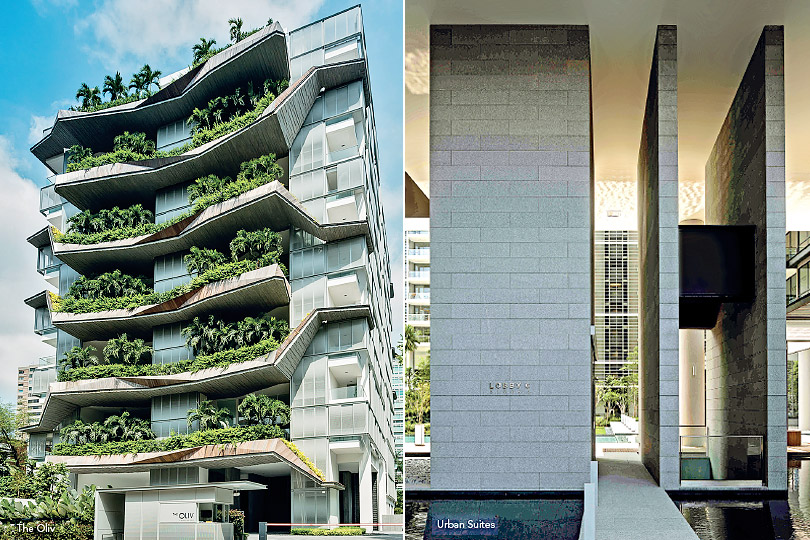
Category: A3 Individual Houses
Project: Chiltern House
Architect: WOW Architects & Warner Wong Design
Award Category: Design Award
The jury is pleasantly surprised by the subtleties and synergy among the architecture, interior design and landscape of this bungalow unit. Despite the ubiquitous square geometry of the house, its interplay of spatial and visual continuity of living spaces with outdoor gardens and pools provides a creative concept that connects the family with nature. The strong architectural language of deep spaces and extensive fenestrations also evokes a strong sense feeling of spatial expansion and serenity that roots the family in their environment. Overall, Chiltern House is successful in achieving an integrated experience of architecture, interior design and landscape, where the marriage of rich spatial and material composition with tranquillity of the environment becomes its dominant architectural language.
Category: A4 Terrace / Semi-Detached HousesProject: Terrace House
Architect: Formwerkz Architects
Award Category: Best Project under S$2 Million and Design Award
The jury applauds the unpretentious and powerful portrayal of rich architectural qualities of this semi-detached house, re-built for a multi-generation family who has stayed in the same street for the past forty years. The architect has not only successfully interpreted the client’s brief for an extended household, to achieve extended and interconnected dwelling spaces, new dimensions of spatial experience are created through the skilful and seamless integration of indoor and outdoor environments, to create an environmentally responsive and architecturally dynamic habitat. Expressed as an introverted and unassuming structure overran with wild landscape from the streets, the panel is delighted by the voluminous spaces within, especially the central landscaped atrium in which the house is organised around, where the communal spaces are spatially connected at all floors to encourage greater interaction within the extended family. The terracing rooftop culminates the experiential journey as a place of respite amidst the changing surrounding landscape, further heightening senses of richness and integration with the whole and nature.

Category: A4 Terrace / Semi-Detached Houses
Project: House of Memories at Holland Grove Terrace
Architect: a d lab pte ltd
Award Category: Honourable Mention
The House of Memories celebrates a unique aspect of memories of a previous dwelling that resided in the same site which features specific qualities of sense of arrival, bright open spaces and double pitched roof, specifically requested as desired elements by the inhabitants. The architect capitalises on a lofty shared courtyard with water features to anchor the house, shared by two households, as a central space that links all the levels of the house, while providing cross ventilation and ambient occlusion.
Formally, the elongated proportions in the new design allowed the line of the pitch and roof eave to be stretched across the frontage of both houses, depicting cohesion between both houses while retaining their individual identities through differing porosity of the courtyards of the houses within its surroundings and for the occupants. Overall, the project is commended for its proficient expression in reimagining an aged house and considerable skills are shown while retaining the subliminal essence of the original House of Memories.
Category: A6 Public HousingProject: Segar Grove (Bukit Panjang N4 C14)
Architect: Surbana International Consultants Pte Ltd
Award Category: Honourable Mention
Segar Grove is a refreshing piece of public housing project that draws its design inspirations from its surroundings assemblage formed among the park connector of Bukit Panjang neighbourhood park and Bukit Timah nature reserve. The project demonstrates well-considered placement of residential blocks to maximise best possible views of surrounding context, internal landscape and courtyard spaces, as well as sustainable considerations of maximising cross-ventilation for all common spaces and units. Architecturally, there are various thoughtful attempts to create a differentiating identity with its wavelike terrain and meandering layout of the blocks, as well as its assemblage of façade features, materiality and colours, signifying various forestry themes. In all, the jury celebrates Segar Grove as a credible effort to provide residents with a closer experience with nature, with quality environments that benefit the whole neighbourhood and bring the community together.

2. Category: Commercial Projects
Category: B4: HotelProject: Holiday Inn Express Clark Quay Singapore
Architect: RSP Architects Planners & Engineers (Pte) Ltd
Award Category: Design Award
The narrow site and climatic challenge were more inspirational than a constraint for the team behind this impressionable piece of architecture. The architects were adept in transforming an effective sunshading solution into an iconic architectural language for the hotel development. The spaces are efficiently planned, with interesting visual layering across several courtyards which also provided good cross-ventilation along the common corridors. All in all, it is an interesting architectural response to site, climate and budget.
3. Category: Institutional Projects
Category: C2 Religious Buildings (Churches, Temples, Mosques etc.)Project: Christ Methodist Church
Architect: K2LD Architects Pte Ltd
Award Category: Design Award
Christ Methodist Church is a refreshing piece of architecture aimed to challenge and reimagine conventional design and archetypes of a church. The excitement of the project stems from various aspects, from its characteristic wave-like formal expression, to its varying façades of illuminated tiny crosses, or elevation of dynamic light and linear installations, as well as its open and inviting social spaces. Besides different incidents of intelligent dual uses of spaces, spatial interest is also created through its volumetric play at circulatory cores that connects different levels of communal spaces within. In material and tactile qualities, the soft colours and delicate textures of the internal wall surfaces provide a humbling and serene atmosphere that complements the spiritual setting of the building. Overall, the jury compliments the architect for a well-executed building and a commendable effort with an inventive alternate interpretation of architecture of this nature.
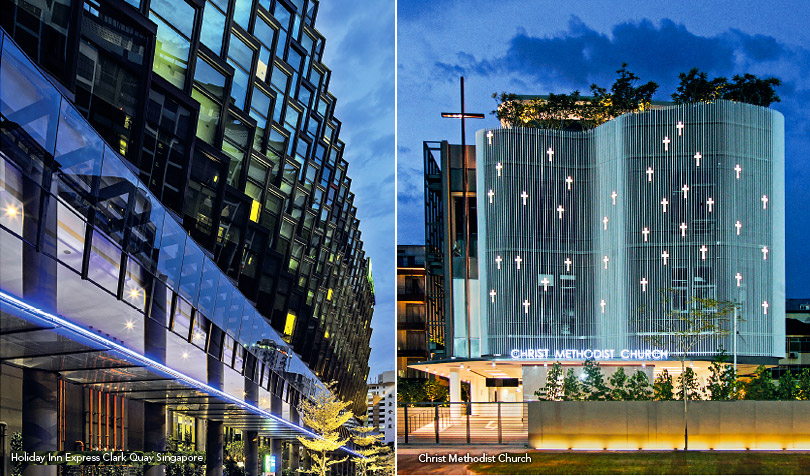
Category: C3 Community Buildings (Community Centres / Libraries / Museums etc.)
Project: National Design Centre
Architect: SCDA Architects Pte Ltd
Award Category: Design Award
The jury commends the tremendous effort behind this architectural marriage of old and new as well as movement and effects in this institutional project. Respecting the essence of the existing conserved building, the architect seeks to draw people into the Design Centre from the surrounding streetscape through the play of volumetric elements, super-graphics, materiality of steel frames and aluminium mesh screens, as well as the glazed retail spaces to entice movement of people in a certain direction showcases. An array of enhancement achieved by adaptive elements, where cladded boxes are strategically positioned to optimize for a vast array of areas for display and exhibitions, also helped creates interest to increase the flow of people into the previously enclosed courtyard. The proficient control of this palette of rich tectonic qualities of light, shade and tactility, through a mixture of solids and voids, is apparent through the juxtaposition of the interior and external, as well as the existing and modern façades. Moreover, an open landscaped terrace on the existing flat roof timber decked area provides a space for the public’s interaction. In all, the National Design Centre is a refined piece of architecture that successfully showcases accomplished architectural techniques in retrofitting an old canvas, to inject the building with relevance and fresh lease of life.
Category: C1 Educational Buildings (Schools, universities, polytechnics etc.)Project: Stephen Riady Centre
Architect: DP Architects Pte Ltd
Award Category: Honourable Mention
The jury is drawn by the dynamic qualities of this institution as a vibrant cluster of spaces, bringing diverse groups of student communities into this social melting pot. Considerable creative skills are exercised by the architect in shaping the spatial and programmatic content in this skewed site, where a datum spine of dual-stacked of pedestrian linkages and shared domains, generates key sense of movement and spontaneity with an array of functional plug-ins along with a multitude of breakout spaces. The central forum that acts as the fulcrum with major confluences of paths, is also well designed as a strategic node of bringing in daylight and effective natural ventilation into the internal spaces. The project is undoubtedly successful in combining programmatic diversity with seamless connectivity, injecting a distinct sense of place in this destination for the student communities.

Category: C1 Educational Buildings (Schools, universities, polytechnic etc.)
Project: Branksome Hall Asia at Jeju Global Education City
Architect: MKPL Designs Pte Ltd in collaboration with Samoo Architects & Engineers
Award Category: Honourable Mention
This institution is an exemplary sustainable campus situated on Jeju Island, a World Heritage site where the design draws inspiration from its unique natural setting, local culture and history, as well as the local climate. The learning centers of Branksome Hall Asia campus are envisioned as “sculptures in the landscape” interconnected by meandering paths within the lushly landscaped central green zone of “Living Forest”. Besides enhancing connectivity between two dividing plots to the outdoors and surrounding mountainous landscape, the development also provides key connections between the school and its community. Anchored at the central green, a main circulation spine effectively links all parts of the school to another common datum, to the Campus Plaza – a main event place and social heart of the school. In terms of spatial planning, the design advocates multi-functionality of facilities, ‘blurring the boundaries’ between circulation-program space, inside-outside and formal-informal zones to optimize them for learning. The jury awards the project for a well-conceived learning hub enlivened by circulation, programmatic synergies and maximum flexibility, as well as well integrated various environmental features to ensure the centre is climatically-responsive and ecologically-sensitive.
Category: C1 Educational Buildings (Schools, universities, polytechnic etc.)Project: Four Acres Singapore
Architect: DP Architects Pte Ltd
Award Category: Honourable Mention
The appeal of the project lies in the harmonising between the old and new where the new training and development facility, marries in a bold yet harmonious gesture of a giant flowing green roof with the ten existing aged bungalows. Respecting the original identity of the green lung site of Nepal Hill, the architect intently meanders the building around precious flora, while trees that were uprooted were creatively recycled as makeshift street furniture. Shaping the architecture closely to existing typography, landscape and architecture integrates through introduction of light shafts and skylights, amalgamated with streams of water and sculpted trees that allow natural light to illuminate learning rooms and corridors. Extensive greenery, vertical and horizontal, creates both aesthetic and environmental qualities that adds further delight to the external and interior of what the jury felt was an overall charming project.

Category: C3 Community Buildings (Community Centres / Libraries / Museums etc.)
Project: Good Shepherd Place
Architect: LAUD Architects Pte Ltd
Award Category: Honourable Mention
The jury felt that Good Shepherd Place clearly exhibits the idea of different components living “under one roof”. Despite the individualistic character of each component, the architecture has been quite effectively unified by the landscape and its elements. With a large planted courtyard serving as the heart of the kindergarten shaped similar to a “leaf-shaped” donut, these landscape features also serves as natural boundaries reminiscent of the old Marymount green settings. Further injection of characters through the therapeutic landscaping are the cascading gardens of the Sister’s Residences, as well as the extra private spaces are thus created due to the complementary gardens, where all occupants have direct access to these lush greenery. The architect also displayed creativity in overcoming security of the Children’s Home by locating living rooms directly outside each dormitory, maximising visual connection to the green whilst maintaining ease of monitoring. In essence, Good Shepherd Place is a purposeful design that integrates environment to the best interests of its inhabitants.
Category: C4 Healthcare Buildings (Hospitals / Polyclinics etc.)Project: NUH Medical Centre
Architect: CIAP Architects Pte Ltd
Award Category: Honourable Mention
A primarily patient-centric design, the jury is impressed by this building’s distinctive architectural outlook and its features which incorporates various accessibility and convenience aids. Dedicated lifts and escalators, to name, are a few of the key elements for convenience. The flow of people is adeptly integrated by ensuring building circulation routes ties seamlessly with the MRT to minimise congestion of the large influx of outpatients. Amenities, views of nature and strategically positioned sky and roof gardens are some positive elements that connect architectural design with people emotions. Furthermore, the architect’s design of educational and research spaces provide people with an opportunity to share, discuss and interact. A bold design change is the usage of elevated bunkers to house radiotherapy facilities, the architect’s other skills are shown by designing natural lit corridors which show juxtaposition to the radiotherapy facilities. In conclusion, the medical centre incorporation of greenery and light in the architectural design functions as an organic complement to the development.
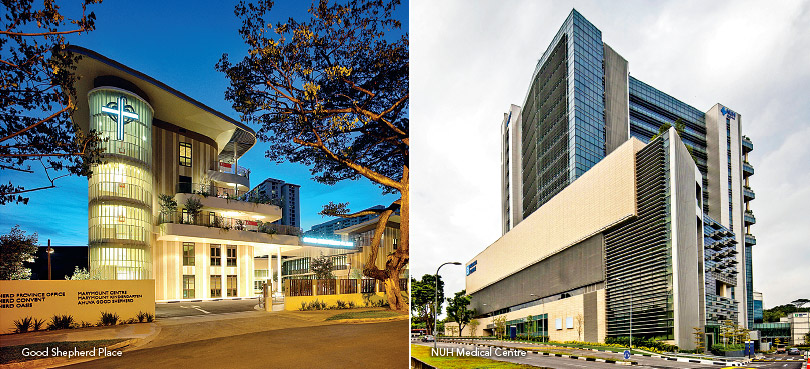
4. Category: Industrial, Transport & Infrastructure Projects
Category: D1 Industrial BuildingsProject: Audi Centre Singapore
Architect: ONG&ONG Pte Ltd
Award Category: Design Award
The jury celebrates the Audi Centre as an appealing piece of contemporary architecture that seamlessly integrates offices, services and a showroom into one dynamic whole. Turning the tight site constraints into opportunities, the architect created an atypical typology of vertical stacked car showroom, servicing and sales, its curved façade showcases a bold design cleverly optimised change that reinvents the conventional horizontal design and experience of other Audi car showrooms worldwide. Interestingly, through the stacking, besides enhanced operational efficiency and flow of customers, the vertical progression of various programmes also heightened experience of vitality and prestige for visitors moving from one level to another. Externally, the hexagonal cut-outs of aluminium of honeycomb pattern coupled with the full-length glass windows gives the impression of the building floating off the ground while adding a sense of futurism. This sophisticated outlook aims to resonate within onlookers Audi’s signature branding image. Overall, the project successfully functions as a mixed development which offers a one-stop solution that offers refreshed service as well as experiential concepts.
Category: D1 Industrial BuildingsProject: Sunray Headquarters
Architect: DP Architects Pte Ltd
Award Category: Design Award
The jury is captivated by the delightful emergence of this landmark building situated within an unexpected context of harsh industrial setting. The massing draws inspiration from its inherent trade of wood work, expressed in a dynamic assemblage of elevated boxes, housing various programmes such as workshop, offices, accommodations and showroom. Intuitive usage of deep recesses allow light to illuminate further into the building and create notable points of ingress and egress. Depicted primarily in subtle shades of the yellow, as a tribute to the company’s corporate colour, the language of aluminium louvres that encapsulates these boxes goes beyond outlook and effect. The louvred facades not only introduce natural daylight and ventilation for the spaces, they are articulated differently, either by orientation or with punctuations of voids and fenestrations to respond meaningfully to the nature of its internal functions and facilities. Inwardly, each space is carefully crafted to the specifications and needs of users occupying the space where efficient flow of workers is heavily emphasised by the deliberate separation of operations by boxes and contiguous spaces that increase efficiency in production. The panel will also like to specially commend the client’s distinguished taste to allow the architect to push and develop a unique architectural product like this that departs from most buildings of similar typology and use.
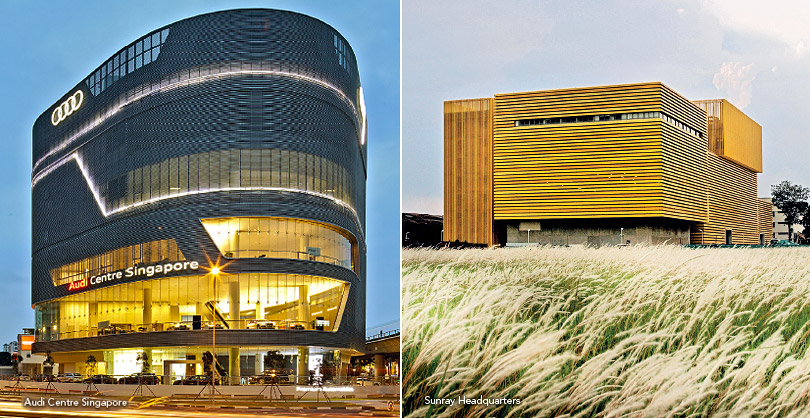
5. Category: Special Categories
Category: E1 Urban DesignProject: Bidadari Estate Master Plan
Architect: MKPL Architects Pte Ltd in collaboration with Urban Strategies Inc. and Housing and Development Board
Award Category: Design Award
Bidadari Estate Masterplan is an exciting housing development masterplan with the vision of creating a “Community in a Garden”, that will be supporting neighbourhoods and surrounding communities, with homes to 40,000 people. The conceptualisation of the Bidadari Estate signifies the confluence of key park-scapes and connectors in regional scale, complemented by an extensive network of pedestrian and cycle paths, exploring communal relationships with the natural environment, including a unique combination of activities, diversity, architecture and open spaces. Part of the masterplan’s appeal lies in the five distinct proposed neighbourhood, each reinforcing the sense of a continuous park with generously landscaped frontages, where parking and servicing will be seamlessly integrated into perimeter blocks or discreetly tucked under landscaped terrains. The park’s rolling topography and wooded landscapes will also be preserved and enhanced, with the integration of lakes, rain and memory gardens, play grounds, numerous leisure, recreational and community facilities, to ensure that the park meaningfully resonates with broad and diverse communities for generations to come. The jury applauds to the of this grand masterplan vision, with a refreshingly integrated and inspired approach to urban, architectural and landscape design supported by strategic infrastructure.
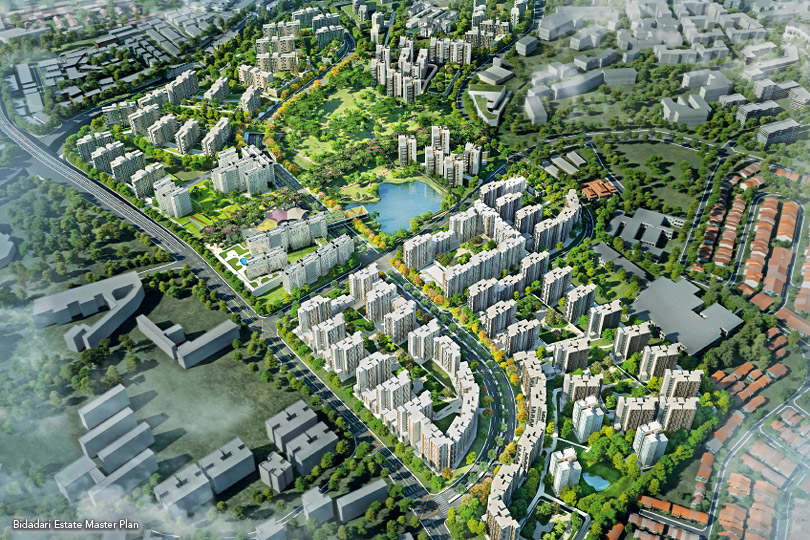
Project: Singapore Sports Hub
Architect: DP Architects in collaboration with Arup Associates
Award Category: Design Award
The Singapore Sports Hub has been presented a design award for the architectural team's commendable effort for completing a project of this scale and complexity, successfully developing a special typology with little local references or precedence. Sports Hub provides a unique ecosystem of sports, leisure and entertainment spaces, bridging Singapore’s expanding urban landscape, as well as the wider public community. The project offers a new model for adaptability and social integration, where it functions both as a premier sports destination, and inclusive public realm that encourages community participation throughout the year. The Sports Hub precinct master plan fully capitalises the site’s strategic location, to create a new landmark destination well connected to various major vehicular, pedestrian, cycling, infrastructural and green network, accessible to and fro the wider city centre context as well as surrounding residential areas. At an urban scale, the Sports Hub through its characteristic urban form, produces a new urban skyline along the Kallang Basin. Epitomising the key essence of the architectural ideologies, the new National Stadium demonstrates the full integration, where architecture, engineering and environmental design meet to support a wide range of flexibility and sports and leisure events throughout the year, with its movable roofs and retractable seats and comfort cooling. The interesting dialectic of the other key element of podium building that surrounds the National Stadium, encompasses the rest of the facilities and creates varied architectural subtleties and richer humanised scale. In addition, the precinct also generates a host of refreshing public spaces such as the Sports Promenade, the OCBC Square that functions as effective holding areas during event days, and on non-event days, inspire participation from the community 24/7.
Beyond providing quality public waterfront and landscaped environments and maximising greenery, various passive cooling measures, innovative engineering and highly sustainable solutions have also been integrated into the design, to ensure minimal use of natural resources, reflecting the ethos of Sports Hub to be a truly sustainable development, economically, socially, and environmentally.
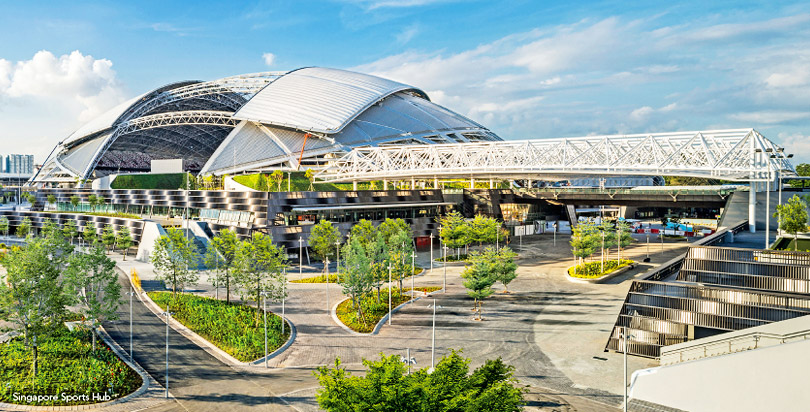
Project: House with Courtyards
Architect: RT+Q Architects Pte Ltd
Award Category: Honourable Mention
The jury compliments the accomplished additions and alterations work on this existing House at Camden Park with feature courtyards filled with large trees rising from the lower ground, to create visual and spatial separation between the programs and bring air and light to the lower ground floors. The design conserves the scale and essence of the original house, while catering additional programs. Substantial skill and effort in planning and detailing are demonstrated through the integration of the linear block, with three distinct aluminium cladded boxes of bedrooms, extending from the existing house, to create a seamless transition from old to the new. A lower ground floor proposed to fulfil programmatic requirements also created dramatic spatial sections, where glass bridges with glass floors span across the courtyards, filled with greenery to recreate the drama of a treetop walk. The jury commends the finesse of the project with its tectonics and successful green efforts that created a highly habitable dwelling of greenery, light and air.
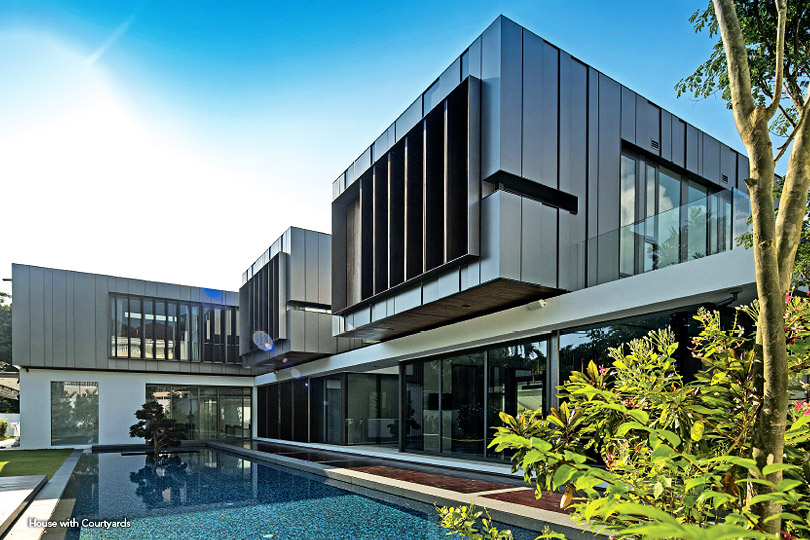
6. Category: Interior Architecture Projects
Category: F2 CommercialProject: Architect’s Office at Kim Yam Road
Architect: Park + Associates Pte Ltd
Award Category: Design Award
The mark of a well-considered and well-executed interior begins with an understanding of the existing architecture, structure and history of a building. The Architect's Office at Kim Yam Road goes much deeper than mere surface treatment by respecting firstly the existing barrel vault roof structural system which was used to create a column-free long-span space for a school library, as was common in the 1960s when the existing structure was built. The sense of arrival is created at the foyer, where the impressive triple-volume space within the first barrel vault is accentuated with black steel pilasters and arches, and a stair/bridge that takes the visitor to the reception. Surprisingly at the reception, the visitor arrives at a pantry which is expressed as a hip cafe, which is featured as the social heart of the office. The attention to detail is extraordinary, from respecting and replicating the original glass louvre windows, to bold strokes of dark accents, custom-made furniture, well-crafted lighting effects, all the way to laying out workstations in alignment with the barrel vaults, presenting a unified concept which brings out the strong personality of the original building. The enhancement of the intrinsic quality and beauty of the existing space, through the new interior treatment and orchestration of such a varied spatial experience has given the jury a lasting impression of the project. The jury gives this project a design award for the design of a creative office environment which challenges convention in a highly refined and tasteful manner.
Category: F2 CommercialProject: Lattice Office
Architect: FDAT Architects
Award Category: Design Award
The effective use of kit of parts for pre-fabrication and fast installation allowed the office, with a compact footprint of 1000 square feet, to be designed and put together in just 6 weeks. The architect developed a series of lattice shelves, inspired by the structures of the kelong, abstracted into a rhythmic structure of vertical timber rods and horizontal plywood planks. These slide in and out within the lattice, ingeniously creating spaces of different widths and heights for books and objects of different sizes, functions as a screen to the studio beyond, and most significantly gives the office a unique character. Creative and flexible use of spaces within the small footprint, for social and creative events, as well as the thoughtfully designed atmospheric lighting adds warmth and interest into this highly socialised workspace. The jury commends this innovative approach by the architect to express a study of systems and recombining standard components to form a complex and versatile office whole.
Category: F1 ResidentialProject: Chiltern House
Architect: WOW Architects & Warner Wong Design
Award Category: Honourable Mention
The appreciation of the interior qualities of the Chiltern House begins with how its ubiquitous massing of off-form concrete is suspended high above the ground floor to maximise light, cross ventilation and the presence of the landscape. The interior is conceived as an extension of the architectural and landscape spaces that define the space within, with a range of architectural material and textures. Spatially dynamic, the spaces within the house is organised in clearly defined layers connected by an impressive four storey stair with tall windows that let light in. Along the length of the living and dining room, a low bay window ledge cast into the folds of the wall and a long horizontal window opening provide an intimate and direct connection to the landscape. The jury commends the overall rigour in the detailing and material exploration to achieve a dwelling centred around functionality, environment and togetherness. 7. Category: Greenscape Projects Category: G2 Landscape, Parks and Park Connectors Project: Zhongshan Park Architect: DP Architects Pte Ltd Award Category: Design Award Zhongshan Park is an important addition to Balestier and can be the catalyst to rejuvenate the area. The park functions as a communal space and an inviting refuge from the heavy vehicular traffic along Balestier Road. It succeeds in providing a visual link to the culturally significant Sun Yat Sen Nanyang Memorial Hall. The park is a series of courtyard and event spaces utilising Chinese landscape elements with a contemporary twist and designed around several large conserved Banyan trees. Pavilions inspired by Chinese, Colonial and Peranakan architecture frames the park and its low-rise massing and placement serves to mediate between the human scale of the park and the large hotel blocks behind. It is a popular space with residents and visitors. As such the jury is unanimous that the Zhongshan park project deserves a Design Award. Category: G1 High-rise Greenery Project: Treehouse Architect: ADDP Architects LLP Award Category: Honourable Mention The professionally executed vertical green facade gave the condominium development a singular bold statement, helping it to stand out amongst its neighbours and yet offering a continuation of the surrounding green at the same time. It is a simple, low-tech solution that minimises maintenance, as well as an effective climatic response to the western sun. It is a commendable effort by the design team and the developer who persevered to implement this big idea.
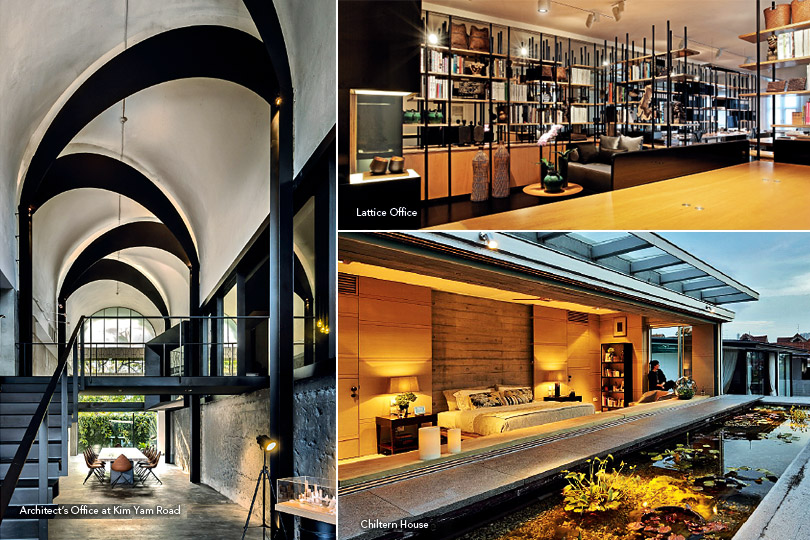
7. Category: Greenscape Projects
Category: G2 Landscape, Parks and Park Connectors
Project: Zhongshan Park
Architect: DP Architects Pte Ltd
Award Category: Design Award
Zhongshan Park is an important addition to Balestier and can be the catalyst to rejuvenate the area. The park functions as a communal space and an inviting refuge from the heavy vehicular traffic along Balestier Road. It succeeds in providing a visual link to the culturally significant Sun Yat Sen Nanyang Memorial Hall. The park is a series of courtyard and event spaces utilising Chinese landscape elements with a contemporary twist and designed around several large conserved Banyan trees. Pavilions inspired by Chinese, Colonial and Peranakan architecture frames the park and its low-rise massing and placement serves to mediate between the human scale of the park and the large hotel blocks behind. It is a popular space with residents and visitors. As such the jury is unanimous that the Zhongshan park project deserves a Design Award.
Category: G1 High-rise Greenery
Project: Treehouse
Architect: ADDP Architects LLP
Award Category: Honourable Mention
The professionally executed vertical green facade gave the condominium development a singular bold statement, helping it to stand out amongst its neighbours and yet offering a continuation of the surrounding green at the same time. It is a simple, low-tech solution that minimises maintenance, as well as an effective climatic response to the western sun. It is a commendable effort by the design team and the developer who persevered to implement this big idea.
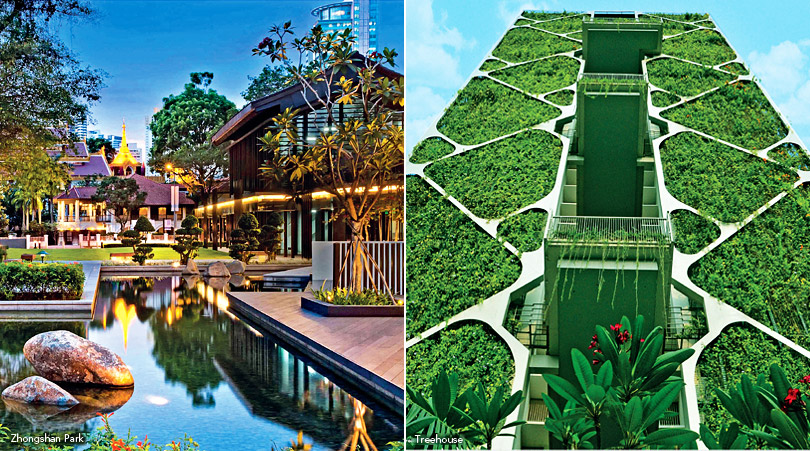
This feature is courtesy of the Singapore Institute of Architects.
The SIA-Uniseal G-Architect Award is an honour that is bestowed annually on an Asian architect. A G-Architect is an individual who, through his/her body of as-built and/or theoretical projects of varied scale-ability, advances and advocates the theory and design practice of sustainable architecture.
G-Architect designs display integration between the natural and manmade systems, and craft and technology. In addition, he/she designs celebrate sustainable architecture and environmental performance.
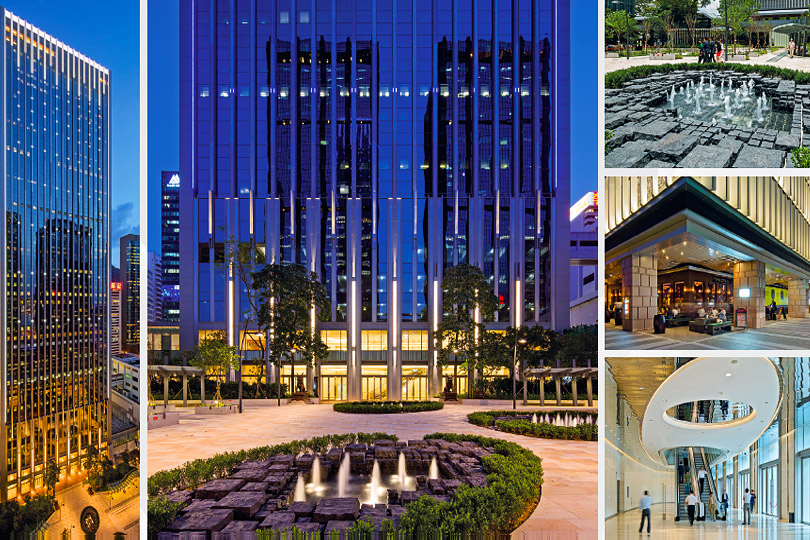
- Have evidenced a broad and deep body of sustainable built works that advance sustainable architecture.
- Have contributed a significant pool of knowledge that advocates practice and eco-literacy of sustainable architecture.
- Have attained a wide recognition amongst the nominee’s fraternity.
- Other aspects of the nominee’s work or life experience deserving of recognition.
The jury panel comprises:
- Mr Theodore Chan (President, Singapore Institute of Architects)
- Mr James Lim (Chief Executive Officer, Uniseal Pte Ltd)
- Dr Uma Maheswaran (Vice President of Sustainability Unit, Jurong Consultants)
- Mr Ng Eng Kiong (President, Singapore Green Building Council)
- Ar Tan Pei Ing (Chairman, Architects Regional Coucail Asia, ARCASIA)
Facilitator: Mr Cheong Yew Kee (Chairman, SIA Sustainability Committee)
2014 Laureate: Mr Leung Man Kit, Director of Sustainable Design, Ronald Lu & Partners (HK)
LEUNG MAN KIT
HKIA, RIBA, LEED AP, BEAM Professional
LEUNG Man Kit (MK), from Hong Kong, is the first recipient of the inaugural SIA-Uniseal G-Architect award. A unanimous choice by jurors and a truly deserving recipient by all measures.
“Consistent”, “ever-evolving” and “place-specific” are some phrases the jurors used. MK’s body of as-built works displayed varied scale-ability, and through his active professional and academic works and institutional servant leadership, he has contributed to advance and advocate the practice and theory of sustainable architecture in Hong Kong.
MK’s body of work exemplifies a systemic thought process in project development and increasing sophistication and maturity in design and implementation. All jurors felt his sustainable journey is admirable. His portfolio demonstrated breadth and depth, culminating in his leadership in the first Zero Carbon Building in Hong Kong. A highly renowned sustainable project and well respected amongst the professional peers.
Breadth in projects spanned from sustainable master-planning to new buildings and regeneration of heritage buildings and sites. Depth varied from design to detailing, advocacy to research and initiating integrated dialogues with multi-stakeholders. Jurors praised the Siu Sai Wan Complex as an exemplary manifestation of an idea, with spaces well translated and urban planning challenges sensitively resolved by massing and façade treatments,
A few insightful remarks by jurors:
“MK’s body of work demonstrated scale-ability from planning to detail and design sensitivity from building orientation to façade”.
“MK’s response evoked attempts to raise the sustainability bar. Most often by his own measures and not by following a set of prescribed corporate or regulatory requirements”.
“MK’s design celebrated spaces and is a response to environment and place. Facade is tailored. Internal spaces with different volume are treated differently”.
“MK’s advocacy of BIM planning is evident and of pushing the green agenda is evident from intent to implementation”.
The juror is heartened MK’s architecture is future-driven and, by his rigor to initiate dialogues and persistence to explore design, serves as a useful tool and, certainly worthy to be emulated by his peers. A truly deserving recipient of the inaugural G-Award.
This feature is courtesy of the Singapore Institute of Architects.
The SIA-Rigel Bathroom Design Awards were established to stimulate and encourage new ideas, innovations and development in the world of intelligent bathroom design. As a leader in green restroom design for over two decades, with groundbreaking solutions that have advanced clean comfort and luxury, Rigel has witnessed remarkable growth in the sector, and sees the potential for far more. Our aim is to foster greater effort and commitment to the advance of sanitary technology and design.
Objectives
- To promote and recognise excellence in bathroom design
- To encourage innovation and creativity in the use of bathroom materials, equipment, facilities and technology in designing a wellness environment in the bathroom
- To encourage sustainable and environmentally friendly bathroom design
Category A: Completed Projects
A1) Completed Commercial Projects by ProfessionalsA2) Completed Hotel and Residential Projects by Professionals
Category B: Hypothetical Projects
B1) Hypothetical Projects by Students OnlyJudging Criteria
The main criteria for judging are:
- Conceptual quality
- Creativity and innovation
- Use of materials and technology
- Environmental sustainability
- Architectural design merit
- Holistic approach (include usability and accessibility)
- Quality of workmanship
The awards is looking for design excellence, with innovative solutions for the bathroom, incorporating environmentally friendly features and universal design principles, as well as the combined use of bathroom materials, equipment and facilities and technology to achieve the wellness and comfort of the user.
For the Hypothetical Category (Category B1), the award is looking for creativity of the proposals, which should not be constrained by the viability of the proposal but should endeavour to conceive the bathroom that could be built. The awards is also looking for new visions of the future bathroom.
Jury CompositionThe jury for the Award will comprise the following:
- Mr Theodore Chan, President of Singapore Institute of Architects (SIA) (Chairperson)
- Ms Chan Ai Lynne, Real Estate Developers Association of Singapore (REDAS)
- Mr Hoong Bee Lok, Senior Director (Campus) of Singapore University of Technology and Design (SUTD)
- One Laureate of President’s Design Award (PDA)
- One Representative from World Toilet Organization (WTO)
Facilitator / Moderator:
Mr Seah Chee Huang, Chairman of SIA Awards Committee
Category A: Completed Projects
1) Bay East Interim Park (BATHROOM DESIGN AWARD)Architect: CPG Consultants Pte Ltd
Client: Gardens by the Bay

2) Gallery Shophouse at Marshall Road (Honourable Mention)
Architect: TAKE Architects
Client: Mr David Chua

Category B: Hypothetical Projects
1) CATER-PEE (Honourable Mention)Student Designer: Ms Gloria Neo

This feature is courtesy of the Singapore Institute of Architects.








